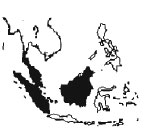Varanus Rudicollis
Gray 1845Rough-necked monitor, flute monitor, harlequin monitor.
 |
This monitor is said to reach a maximum size of 180cm (Wong, pers. comm.) but the largest specimen recorded measured 146cm TL (59cm SVL) and weighed just over 4kg (Harrison & Lim 1957). According to Lekagul (1969)), in Thailand they wely exceed 100cm in length. Wild specimens of about 40cm SVL in Malaysia weigh around 2kg (Lim, pers. comm.). The rough-necked monitor is easily recognised by the large pointed scales that adorn the necks of adults. The purpose of these scales is unknown, indeed, the entire natural history of this magnificent animal is shrouded in mystery. They are found only in primary and secondary rainforest and in mangrove swamps. Although they are said to avoid human settlements and many life-long forest inhabitants are unaware of its presence, an adult has been found sheltering in a disused washing machine at a small camp deep in the Malaysian rainforest (Bennett & Lim in press). Direct observations of this species in the wild are scarce; Ladiges (1939) encountered one in Sumatra resting on a log close to the water that ran up a tree to escape him. Jasmi (19S9) and Nutphand claim that the animals feed mainly on the ground and climb trees to escape from danger, often sheltering in tree hollows.
The diet of this species is very poorly known. Schnider (in Werner 1900) found only insects in a specimen from Sumatra. Mertens (1942) believed that ants (and possibly termites) formed a major part of the diet and were collected with the tongue. This is conftrmed by Auffenberg (l988 and per's. comm.) who found termites, massive stick insects and tree centipedes in six specimens from Malaysia. One examined by Brandenberg (l983) had a stomach full of large cockroaches and grasshoppers and other from Surat Tharn in Thailand had a stomach full of crabs (Nabhitabhata, pers. comm.). Five examined by Losos & Greene (1988) contained frogs and their eggs, spiders, scorpions, crabs, cockroaches beetles and orthopterans. The rough-necked monitor may be active throughout the year, but is most in evidence during months of heavy rainfall (Nabhitabhata, pers. comm; Bennett & Lim in press)
Rough-necked monitors rarely become lame and show a healthy dislike of humanity. In turn people often fear the lizard. According to Nutphand the species is often known as Ngu-HaoChang (cobra elephant) in Thailand and are often attributed with Ihe ability to spit venom. In Malaysia they are known as biawak serunai (flute monitor) and on Borneo as biawak punggur (rotting tree monitor).
In captivity these monitors often have very nervous dispositions. Providing a very spacious enclosure and allowing the animals to hide above the ground will help them to overcome their shyness. Some authors (e.g. Sprackland 1992) have suggested that the animals are more secure when kept in groups, but care must be exercised because some individuals act in a very aggressive manner towards their conspecifics. Both Horn & Petters (1982) and Nutphand report that young specimens like to bury themselves in damp substrates and that they sometimes act dead when handled. In captivity they will accept a variety of invertebrates (freshwater crabs, earthworms and insects), small mammals, birds and freshwater fish. They need a constantly high temperature (no less than 23°C) and often respond to artificial rainfall by commencing courtship behaviour. Females usually prefer to lay their eggs above ground. Although eggs are often produced in captivity (up to three clutches per year each containing up to 14 eggs (Mehaffey in Bennett 1993b)) they rarely hatch. Eggs laid by a recently imported female were hatched successfuUy by Horn & Petters (1982) after 180-184 days imcubation at 28-30°C. Hatchlings weigh about 21g and measure 25cm TL. Very young specimens have yellow bands over the body that disperse with age. Whilst adults from Thailand and Malaysia are often almost completely black, those from Borneo and Sumatra may be brighter in colour.
Attribution / Courtesy: Daniel Bennett. 1995. A Little Book of Monitor Lizards. Viper Press U.K.




